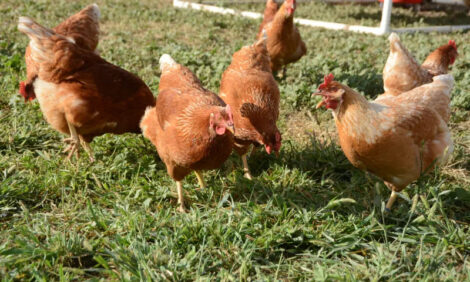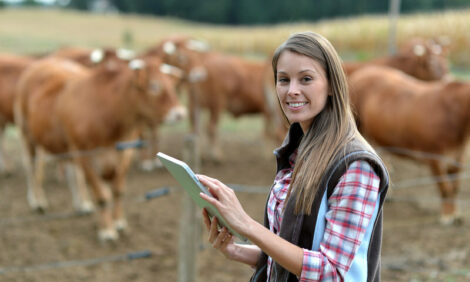



NCBA: Ruaraidh Petre outlines GRSB’s three global beef industry goals
Global Roundtable for Sustainable Beef’s executive director updates program progress and differences across the global beef industryRuaraidh Petre, the Executive Director of the Global Roundtable for Sustainable Beef, spoke to The Cattle Site’s Sarah Mikesell at San Antonio, Texas, USA at the National Cattlemen's Beef Association meeting, CattleCon.
What's new at GRSB?
At the end of last year, we produced our first Sustainability Report. We released that at our global conference in Uruguay. That Sustainability Report gives a baseline and an update on all the National Roundtable's progress towards our global goals. This gives us a sort of a stick in the sand as it were as to where we are going and where we have come from. Our global goals are especially important; they're 2030 goals. So clearly, we've got a lot of work to do in the few years until 2030. It's great to see that nine of the 13 roundtables are already able to point to what they're doing to achieve our goals.
We were established in 2012. We set up our principles and criteria back then, and it was really 2021 when we had a sufficient network of round tables around the world that we could set these global goals. If we do it now, we've got an actual chance of meeting them, and this is the first opportunity to show we've got commitment around the world. We're starting to measure things and even on some of them demonstrate progress. It's taken a while but it's worth it.
Showing progress is the goal, right?
Yes, sustainability is not an endpoint. It's just constant progress and making as many changes as you can and as your environment dictates. Every country that we have, we've got 24 countries involved, is different and they've got different issues to deal with. It is complicated to try and boil that down to three goals, but we did that in such a way that each of them can report slightly differently on the things that they have prioritized even though they're contributing to these three global goals.
Tell me about your three global goals.
The goals are one on climate and that's to reduce the emissions intensity of beef production by 30% by 2030. It is ambitious, but intensity means the amount of emission per pound of beef produced. It's not a total amount of emissions; it's the intensity per pound. That's effectively a measure of efficiency of production.
The second part of the goal is on a pathway to climate neutrality, because ultimately that's what we need. We did not set a date for that because it's a big world. It's a big industry. It would not have been realistic for us to say; we can achieve that by whenever. Some of our country members have. The U.S. has a goal for 2040. Australia's has a 2030 goal. Other countries have those goals, but there are many countries that don't. We couldn't with all honesty say, we'll manage that by whenever.
Second goal involves nature positive production. We want to become a net positive contributor to nature by 2030. That, again, is vastly different in different countries. Here in the U.S., you'd be focusing on grazing management, soil health and the health of pastures, making sure that you're getting the best return on your land investment. In some other parts of the world, it might be more to do with deforestation and limiting the amount of deforestation associated with the beef industry. There are all kinds of ways in which the beef industry supports biodiversity and supports nature. Of course, that's what we want to emphasize with our goal.
The final one is on animal health and welfare. That is to provide animals with a life worth living and make sure that they're well-treated throughout their life. That's an ethical imperative for us as well as an efficiency imperative. It's something that contributes very strongly to sustainability, because if you got healthy and well-looked after animals, they're more productive. Ultimately, you need fewer animals to produce the same amount of beef. If you look at the way the U.S. beef industry has evolved over the decades, it has become more and more efficient. That means that the size of the herd has decreased while you have increased the amount of beef produced.
I’ve attended a few of your conferences, Ruaraidh, and I’m always astonished at how different the conditions are that cattle are grown in around the world whether that’s climate, environmental, disease challenges, etc.
Absolutely, cattle are probably one of the most widespread agricultural operations. You can raise cattle on the edge of the Sahara in Africa. You can raise them on the edge of the Arctic Circle or up in Norway. In Scotland in the far north, we're almost on the same line as Juneau, Alaska, and we've got a reasonably sized cattle industry there. We're very wet, but there's other parts of the world which are incredibly dry.
They're all different, not just the physical environment is different. You've got different disease challenges. You've got different legislative environments and diverse cultures.
That is why when we set up the global roundtable; we recognized right from the beginning that we had to have these national groups to fill in the detail. We could come in at an elevated level, but you really need people from each country to talk about the specific challenges. What can we do to address those challenges? If grazing management were your challenge, the solution to grazing management where you come from in the Midwest is completely different to what it would be in Arizona. Let alone in Africa or the Australian Outback.
Who is your target audience for members of the GRSB?
Our membership is drawn from six constituencies.
- Producers - cattle ranchers or farmers and from individuals up to big organizations like NCBA, Cattle Australia, and the Canadian Cattle Association. We've got everything in scale there from the individual rancher right up to tens of thousands of members.
- Processors - companies like Cargill, Tyson, JBS, Minerva and Marfrig. These companies are processing the majority of the of the world's beef. With the members we have in that constituency, we're already reaching about two-thirds of the cross-border trade in beef.
- Allied industries - companies that provide inputs to the beef industry, and those who take off products such as the leather industry, dairy industry and input providers like pharmaceutical companies and financiers.
- Retailers - restaurant retailers and some supermarket retailers.
- Civil societies - NGOs, organizations like the World Wildlife Fund, Solidaridad and others who are collaborating with producers to be more efficient or more sustainable. Also included are academia, such as land grant universities who provide scientific data that we need to prove that what we are doing is better for the environment.
- National round tables – 24 countries that are organized into 13 round tables. Most of them are single countries, but some of them like Europe and southern Africa have five or six countries in them.
That's a lot of diverse groups. Bringing everybody together to try to get global agreement and make decisions must be tough?
It is tough, but with the headwinds that we face and the lack of understanding in policy circles about the importance of livestock within the overall food system, we're seeing increasingly simplistic solutions from policy makers, particularly because of the issue of climate. People come out with statements like “If we just got rid of the cow.” That is just not an option. It doesn't make sense in climate terms, it doesn't make sense in food production terms, and it doesn't make sense in human nutrition terms. All these things are simplistic, and we, as an industry and as a sustainability movement, need to challenge those simplistic assumptions.



